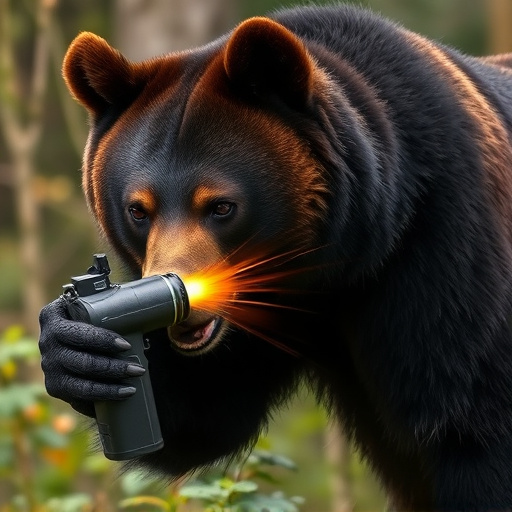Maintaining the Proper Temperature for Bear Spray Storage is crucial for maximizing bear repellent effectiveness in Alaska's wild areas. Extreme heat or cold degrades the spray's chemical composition, reducing its potency and reliability during bear encounters. The ideal storage temperature range is -20°F to 140°F (-29°C to 60°C). Storing bear spray away from direct sunlight, heat sources, and flames, while controlling humidity levels, helps preserve its potency and ensures reliable performance in diverse wildlife settings.
Alaska’s rugged wilderness attracts adventurers, but it also hosts a diverse bear population. Understanding the maximum range of bear repellent is crucial for safety. This article delves into the science behind bear spray effectiveness, exploring factors like weather and storage conditions that impact its range. We guide you on safe usage practices, ensuring your adventures remain uneventful with bears. Learn about the optimal temperature for storage to maintain maximum efficacy.
- Understanding Bear Spray Effectiveness in Alaska
- Factors Affecting Bear Repellent Range
- Optimal Storage Conditions for Maximum Efficacy
- Using Bear Spray Safely and Responsibly
Understanding Bear Spray Effectiveness in Alaska
Bear spray, also known as bear repellent, is a popular choice for individuals venturing into Alaska’s wild areas due to its effectiveness in deterring bears. However, understanding how and when it works best is crucial. The efficiency of bear spray relies heavily on factors like can size, concentration of capsaicin (the active ingredient), weather conditions, distance from the bear, and proper usage technique.
One critical aspect that often goes overlooked is the proper temperature for storage. Bear spray should be kept within a specific range to maintain its potency. Extreme heat or cold can degrade the chemical composition, reducing its effectiveness. Therefore, ensuring the recommended storage conditions is essential to maximize the bear spray’s range and reliability when facing an encounter in Alaska’s diverse wilderness.
Factors Affecting Bear Repellent Range
The effectiveness of a bear repellent, like bear spray, is significantly influenced by several factors that determine its range and performance. One crucial aspect is the proper temperature for bear spray storage. Bear sprays are sensitive to extreme temperatures, which can affect their chemical composition and potency. Extreme heat can cause the ingredients to degrade faster, reducing the concentration of capsaicin and other active compounds responsible for repelling bears. Conversely, very cold temperatures may also impair the spray’s performance by making it more viscous or causing the canister to freeze, impacting its pressure and spraying mechanism.
Other factors, such as humidity and wind conditions, play a significant role in determining the maximum range of bear repellent. Humidity can affect how quickly the spray evaporates, potentially reducing its reach. On the other hand, windy conditions can disperse the spray more rapidly, increasing its effective range but also making it harder to accurately target bears. Understanding these variables is essential for users to make informed decisions when choosing and deploying bear repellents, ensuring maximum protection in various environments.
Optimal Storage Conditions for Maximum Efficacy
To maintain maximum efficacy, proper storage conditions are crucial for Alaska bear repellents, especially bear spray. The ideal temperature range for storing bear spray is between -20°F and 140°F (-29°C to 60°C). Extreme temperatures, both hot and cold, can degrade the active ingredients in the spray, reducing its potency. It’s recommended to keep bear spray out of direct sunlight, as UV rays can also break down the chemical compounds.
Additionally, ensure that the container is sealed tightly and stored away from heat sources or direct exposure to flame. Humidity control is another key factor; too much moisture can lead to corrosion or leakage, while too little humidity might cause the spray to become too dense or thick to dispense properly. Maintaining the proper storage conditions will help extend the lifespan of your bear repellent and ensure its reliability when you need it most in Alaska’s wild environments.
Using Bear Spray Safely and Responsibly
Using bear spray safely and responsibly is paramount when venturing into Alaska’s wilderness. It’s not just about having the repellent; it’s knowing how, when, and where to use it effectively. Always ensure your bear spray is stored at the proper temperature—between -40°F and 120°F (4°C to 49°C)—to maintain optimal performance. Keep it out of direct sunlight and extreme cold, as these conditions can reduce its effectiveness.
When facing a potential bear encounter, stay calm and assess the situation. Only use bear spray when necessary, as misuse can be counterproductive. Aim for the bear’s face and eyes from a safe distance, typically 20-30 feet (6-9 meters). Make sure your back is to a barrier or you have an escape route, then activate the spray and back away slowly. It’s crucial to follow these steps precisely to maximize the repellent’s range and effectiveness, ensuring your safety in the process.
In understanding the effectiveness of bear spray, optimal storage conditions, and responsible usage in Alaska’s unique environment, you’re now equipped with knowledge to ensure maximum protection. The ideal range of 30-80 feet, or the proper temperature for bear spray storage (below 120°F), are crucial factors to maximize efficacy. By following these guidelines, you can enhance your safety while navigating Alaska’s wilderness and mitigate potential bear encounters. Remember, responsible use of bear repellent is key to coexisting harmoniously with these majestic creatures.
